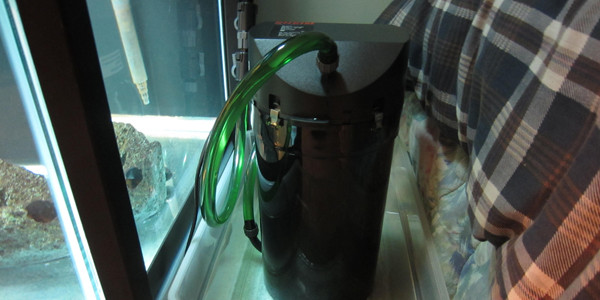Freshwater aquarium filter is a necessity for any fish tank.
The aquarium is an enclosed environment, which is very dense compared to the natural fish habitat.
Due to the density and enclosure, the water gets polluted easier, especially if the tank water is not cycled.
In the natural habitat, the water is balanced and naturally maintained.
When it comes to fish tanks, the goal is to recreate the natural habitat in a relatively small enclosed tank with a high density of plants, fish, and other water inhabitants like snails, shrimps, and more.
Since the aquarium is not self-cleaning and unless the perfect natural balance is achieved, aquarium filters are essential. In fact, you should look into using only the best aquarium filters for your tank.

Table of Contents
The Aquarium Cycle
Aquarium filters come in various types, shapes, sizes, costs, and brand names.
Aquarium filters help maintain clean and safe water for our fish and/or invertebrates and plants.
The beneficial bacteria that convert ammonia from the excretions of the fish produce waste into nitrite.
The ammonia and nitrite are very toxic for the tank’s inhabitants.
Another beneficial bacteria convert nitrite to nitrate, which is less toxic and can then be eliminated from the water with filtration.
There are Three Stages of Filtration
When it comes to freshwater aquarium filters you should consider a filter that has three stages of filtration: mechanical, chemical, and bacterial.
Good quality filters offer all the stages of filtration that is needed for good water quality and healthy, happy fish.
The mechanical filtration consists of the filter catching waste, debris, or other refuse in the tank.
With cleaning, the filter removes all that waste.
Sometimes the waste starts to decompose resulting in chemical changes in the aquarium.
The filter keeps the water clean in order to reduce the chemical change of the tank from decomposition.
Elements like active carbon that are used in the aquarium filters absorb toxins from the water, making it safe for the fish.
The bacterial filtration is the stage where the water goes into the filter’s elements that are concentrated with beneficial bacteria.
Good places for beneficial bacteria to grow in the filter are the bio-sponges, bio cubes, balls, cartridges, and other materials that are included in the filter or commercially sold.
A Common Mistake that Leads to a Loss of Fish
The most important thing when cleaning the bio part of the filter, for example the bio-sponge, is that you clean it (wash it) in the same water that you extracted from your fish tank.
For example, if you use aquarium gravel cleaner when you perform a water change, wash the sponge in the bucket with the water that is removed from the tank.
This is very important because the beneficial bacteria on the bio-sponge is thriving; if you wash it in the sink, the chlorine of the tap water will kill the beneficial bacteria in the bio-sponge, rendering the filter useless for bacterial filtration.
It’s like starting over again from scratch, but the fish tank is already populated, so you might place your fish in a dangerous situation.
Also, when filling your tank with tap water (before adding the fish), treat the water with products that remove chlorine, making the water safe for the fish.
There are products that contain beneficial bacteria recommended for new aquariums or those not properly cycled.
Types of Aquarium Filters
Submersible Aquarium Filter
One of the most common aquarium filters is the submersible aquarium filter that has a power head capable of aerating the water.
They have suction cups that attach to the aquarium glass allowing the water to flow, thus providing filtration.
A good quality filter should have mechanical, chemical, and bacterial filtration.
Hang On Filter
Other types of filters are the waterfall-like ones that are attached to an open fish tank.
They usually provide all three types of filtration if they are good quality ones, but they require replaceable cartridges.
They can also aerate with the small waterfall they create.
Check which one is best for your fish tank by the category of the filter, which is based on the amount of water flow and the size of the fish tank.
Canister Filter
Canisters are top rated and the most expensive filters.
They filter using the three phases of filtration and you can add, remove, or change the filtration material.
Basically, they are containers that have an in-flow of water and an out-flow of water.
Canisters are great filtering devices since they maintain the cleanliness of the water for a longer time than the other aquarium filters.
Also, they are the best option for larger fish tanks because they are powerful filters with vast water flow.
There are canisters available for small, medium, and large fish tanks depending on the amount of water your fish tank holds.
Other Filter
There are also freshwater aquarium filters that consist of sponges and move the water by aeration, but they usually consist of poor performance due to slow water flow.
In addition, there are self-made aquarium filters that work well, sometimes even better than the store-bought brands, if you know what you are doing.
Final Tips
When purchasing a filtration system for your aquarium, the first and most important factor to consider is the size of your tank and the needs of your fish. If you’re looking for the best fish tank filters then head over to pet gear lab.
Filtration is an imperative part of an aquarium’s system so find the right one for your tank.

1 thought on “Choosing the Right Freshwater Aquarium Filter – From 4 Types”
It’s interesting that the bacteria that change ammonia produce waste into nitrite. My sister has been thinking of installing a freshwater aquarium. I’ll pass her the info so she can visit an aquarium shop for more help.